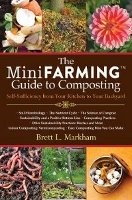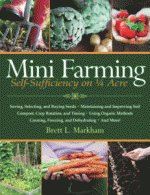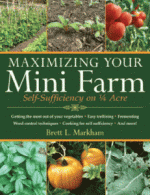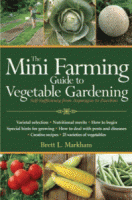One benefit of having a website with a contact form is that I get a lot of feedback and questions. One question that has come up a few times is how to handle vining crops in raised beds. This is a good question because grown traditionally, a single acorn squash plant could take over an entire bed!
I grow vining crops of this sort in one of two ways, depending upon the crop.
Cucumbers, indeterminate tomatoes, sweet potatoes and small melons such as cantaloupe are planted on the North 1″ of the bed, and they are trained on trellises. This gives them maximum access to sunlight without shading other crops, plus leaves the rest of the South side of the bed free for other crops such as lettuce that don’t grow very tall. This allows ordinarily very space-consuming crops to take up a bare minimum of space while still being productive. As an added bonus, the effects of gravity give straighter cucumbers.
No support beyond the basic trellising is needed for tomatoes, cucumbers and sweet potatoes. But the smaller melons are another story! As they ripen, they’ll literally fall off the vine prematurely if unsupported. For this purpose, I use the leggings of old (but washed!) panty-hose. These are made of a stretchable material that will conform to fit the shape of melons without restricting their growth. Once melons get about 4″ in diameter, I tie the cut leggings to the trellising and run them under the melons so the melons are gently supported.
There are limits to this approach, however, because it is utterly impractical for larger melons, and some squash just seem to refuse to be trained. In the case of larger watermelons (“moon and stars” is one of my favorite varieties and it grows fine up north) and vining squash, I instead plant these in the Southern 1′ of the bed and let the vines grow out of the bed Southward toward the sun. I put landscape fabric and (untreated) mulch over the area where the vines will be running, and let them go. This likewise frees up the Northern 3′ of bed for other crops, and keeps the vines protected.
Summer squash and zucchini are bush-type squash plants and they take up a lot of space. I have found, however, that by planting them offset in a pattern similar to a checker board, I can fit eleven plants in a bed. I grow six yellow squash and five zucchini this way. If you have ever grown these, you are undoubtedly familiar with “zucchini surprise.” That is, all of a sudden, the plants just seem to explode and in no time flat you have bushels of zucchini. Yellow summer squash do the same thing. You’ll find that unless you are feeding an army, a single bed of these will be more than sufficient.
On the topic of cucurbits generally (which includes squash, cucumbers, watermelons and gourds), most folks recommend directly seeding these in the garden and watering them until they sprout. I disagree. I have found that starting these indoors a couple of weeks in advance (they sprout quickly) and then planting them out a week after last frost gives them a major head start in the garden for earlier productivity that makes them better able to produce. So I recommend starting these indoors, and then transplanting them. A lot of books say they don’t transplant well; but if they are treated gently they transplant just fine.
Filed under: Squash, Uncategorized, Vegetables








